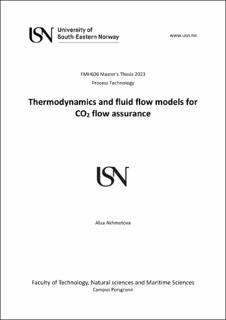| dc.description.abstract | Carbon capture and storage (CCS) has been widely recognized as a potential method for lowering CO2 emissions. MACON CCS is one of the CCS projects introduced in Norway by SINTEF in 2021. The project aims to facilitate large–scale deployment of CCS from industrial sources by solving specific and internationally acknowledged constraints in monitoring and controlling varied industrial CCS transport networks. TechnipFMC is collaborating with SINTEF and working on the project by combining thermodynamics and fluid flow models for CO2 flow assurance.
The present study consists of three investigations: 1) understanding the degree to which the simulation model accurately represents CO2 transport by comparing simulation results to experiments, 2) investigating the effect of adding impurities on CO2 transport through simulations, and 3) completing study research on leakage detection methods suitable for subsea CO2 transport.
Experimental data when CO2 in a single gas, liquid, and two–phase flow was obtained from two experimental setups, one in a vertical and the other in a horizontal pipeline. In addition, the pressure gradient, density, and volume fraction of liquid from the experiments were compared to calculated data from FlowManagerTM and OLGA software.
Analyzing the results when CO2 is pure and in a two–phase flow regime applying numerical calculations precisely on the line where the experiments were taken was complicated based on PT calculations. Hence, according to the calculations in FlowManagerTM, using the PVT table from Multiflash results in poor density performance since the phase transition of CO2 occurred. However, in OLGA, the calculations were based on the PH calculation, which allowed for the accurate estimation of gas and liquid density. There was no observed phase transition phenomenon; hence the pressure drop calculations performed better. A better match between calculated and experimental density significantly improved the model's pressure gradient predictions and volume fraction predictions.
The effect of impurities on the PVT characteristics of CO2 was also investigated. The study discovered that a small quantity of impurities increases the phase envelope of CO2 where it is in a two–phase flow. Therefore, the more impurities CO2 has, the more expansive the area of the two–phase flow regime.
While analyzing SINTEF's experimental results performed in a horizontal flow loop, it was observed that there was an inconsistency between measured and calculated data, with the calculated data underestimating the measured data by up to -50 %. Moreover, it is observed that when pure CO2 is in a single gas or single liquid phase, the calculated pressure gradient values from both software were close to each other. In addition, when calculated densities were compared to NIST data, the relative error was noticeably modest.
SINTEF concluded that the pressure sensors installed on the horizontal flow loop could have an inaccuracy up to 35 % after 5 years of use, especially when the pressure drop between the sensors is very small, as was the case in the study. Therefore, the experiments completed by SINTEF in a horizontal flow loop will be repeated, and simulations with new data will be completed in FlowManagerTM by TechnipFMC. | |
